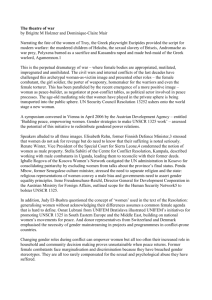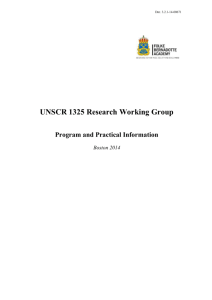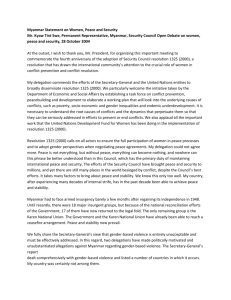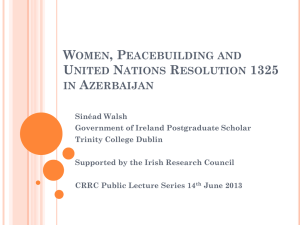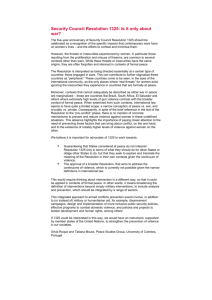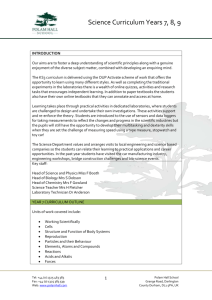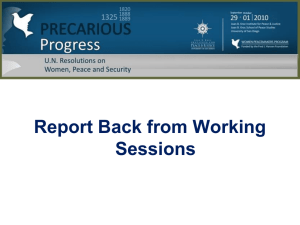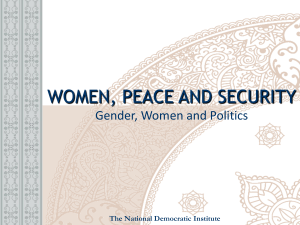Accountable Grant Arrangement (Draft)
advertisement
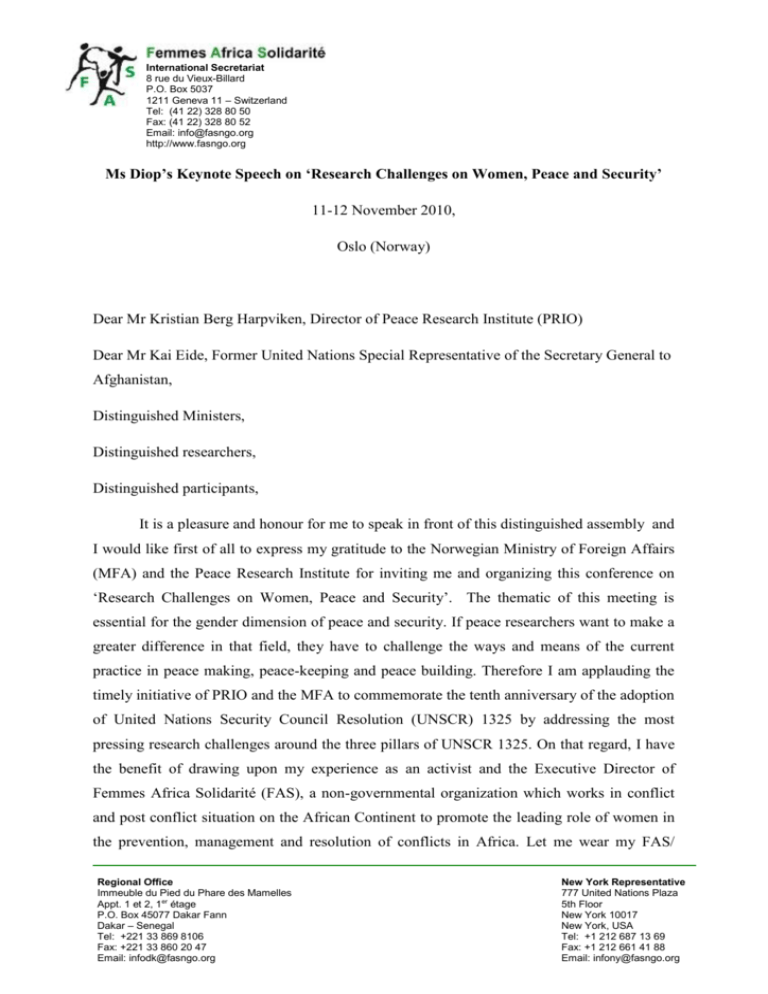
International Secretariat 8 rue du Vieux-Billard P.O. Box 5037 1211 Geneva 11 – Switzerland Tel: (41 22) 328 80 50 Fax: (41 22) 328 80 52 Email: info@fasngo.org http://www.fasngo.org Ms Diop’s Keynote Speech on ‘Research Challenges on Women, Peace and Security’ 11-12 November 2010, Oslo (Norway) Dear Mr Kristian Berg Harpviken, Director of Peace Research Institute (PRIO) Dear Mr Kai Eide, Former United Nations Special Representative of the Secretary General to Afghanistan, Distinguished Ministers, Distinguished researchers, Distinguished participants, It is a pleasure and honour for me to speak in front of this distinguished assembly and I would like first of all to express my gratitude to the Norwegian Ministry of Foreign Affairs (MFA) and the Peace Research Institute for inviting me and organizing this conference on ‘Research Challenges on Women, Peace and Security’. The thematic of this meeting is essential for the gender dimension of peace and security. If peace researchers want to make a greater difference in that field, they have to challenge the ways and means of the current practice in peace making, peace-keeping and peace building. Therefore I am applauding the timely initiative of PRIO and the MFA to commemorate the tenth anniversary of the adoption of United Nations Security Council Resolution (UNSCR) 1325 by addressing the most pressing research challenges around the three pillars of UNSCR 1325. On that regard, I have the benefit of drawing upon my experience as an activist and the Executive Director of Femmes Africa Solidarité (FAS), a non-governmental organization which works in conflict and post conflict situation on the African Continent to promote the leading role of women in the prevention, management and resolution of conflicts in Africa. Let me wear my FAS/ Regional Office Immeuble du Pied du Phare des Mamelles Appt. 1 et 2, 1er étage P.O. Box 45077 Dakar Fann Dakar – Senegal Tel: +221 33 869 8106 Fax: +221 33 860 20 47 Email: infodk@fasngo.org New York Representative 777 United Nations Plaza 5th Floor New York 10017 New York, USA Tel: +1 212 687 13 69 Fax: +1 212 661 41 88 Email: infony@fasngo.org African hat in view of the challenges that remains on the Continent. What my presentation will first address is the objective of UNSCR 1325 and the reason why it was such a groundbreaking resolution. Then, I will stress that despite its far reaching implications, the implementation of UNSCR 1325 was defaulted due to the accountability gap and the lack of clear indicators. In that optic, the 10th anniversary was an opportunity to redress those challenges. In that process, I will underline that although more commitment were made to develop National Action Plan (NAPs) for the ten years to come, there are missing links in its qualitative and quantitative dimension. The last part of my presentation will stress how crucial the academics are to strengthen the analysis of indicators. I will also stress the importance of including in universities’ special mandate to conduct research and data collection in order to publish good practice cases and lessons learned. Talking points 1. 1325 rationale and global aim Resolution 1325 on women, peace and security was the first resolution passed by the Security Council that links women’s experiences of conflict to the international peace and security agenda. It focuses attention on the impact of conflict on women and on women’s contributions to prevent conflict and promote a sustainable peace. UNSCR 1325 was groundbreaking as it produce not only a conceptual shift from a state-centred defence policy approach to security, to a human security approach in which factors such as gender and principles such as equality and empowerment matter issues like water, land, health, etc; but it shifted also the image of women in conflict from that of a victim to that of an active peace builder. It provides for the first legal and political framework for women to engage in peace processes and in peace building. Therefore in his report on Women, Peace and Security (2004), the former Secretary General Kofi Annan declared that ‘Resolution 1325 holds a promise to women across the globe that their rights will be protected and that barriers to their equal participation and full involvement in the maintenance and promotion of sustainable peace will be removed' . 2 UNSCR 1325 includes three pillars of action around the participation, protection and prevention thematic. Through its 18 provisions, UNSCR 1325 provides a framework for participation in activities such as: negotiating peace agreements; planning humanitarian and peacekeeping operations, and rebuilding war torn communities. In terms of protection, the resolution places firm obligations and accountability upon all Members States, the Security Council, the Secretary General and even non-states actors to protect women’s human rights as well as to ensure a gender lens across all peace and security initiatives. The resolution reaffirms the important role of women in the prevention and resolution of conflicts. 2. From Policy to Reality: implementation of UNSCR 1325 Ten years after the adoption of UNSCR 1325 and fifteen years after the Beijing Declaration, In Africa there have been some gains in the implementation of UNSCR 1325. In terms of Participation, in DRC for example, from February 2002 women used UNSCR 1325 to conduct series of consultations, in east and west provinces that finally led to the Nairobi Meeting. Relying on UNSCR 1325, Congolese women have been quick to demand and get a place for the second round of talks, held at Sun City in South Africa. They occupied 40 seats in the 307 representatives, and participated actively in a common structure called the Caucus of Congolese women in the work of the five official committees that were set up in the Dialogue. According to the testimony of the former United Nations Secretary General Kofi Annan, “Congolese women have formed a united and dynamic force which has enabled the dialogue to continue despite the frequent clashes in the negotiations” Congolese Women made a solemn commitment to fight during the transition period for a “system that respects the values of democracy, human rights and fundamental freedoms”. This results in effect by section 51 of the Transitional Constitution of DRC which enshrined not only parity principle but also the government’s pledge to fight all forms of discrimination against women and to 3 ensure the full participation of women in political, social and economic life of the country. How do we measure the negative or positive impact. UNSCR 1325 looks at various aspects among which are special measures to promote women’s rights; to protect women from gender-based violence and other forms of violence and to undertake actions to end impunity. In Africa, through the mobilization of women’s organization some progresses have been made to advance and protect women’s rights: This eventually led to the Protocol to the African Charter on Human and Peoples’ Rights on the Rights of Women in Africa which marked a milestone in the protection and promotion of women’s rights in Africa. In its Preamble and under article 11, the Protocol mainstreamed women’s rights in terms of international standards. In terms of prevention, UNSCR 1325 insisted upon the involvement of women. In the Mano River Region, Mano River Women Peace Network (MARWOPNET's) has been involved in conflict prevention through early responses. They succeed at the peek of the crisis between Liberia, Sierra Leone and Guinea to convince the leadership of the three countries not to go to war and resume their conflict peacefully through negotiation which they did in 2001. A highly distinguished accomplishment of MARWOPNET has been receiving the United Nations Prize in the field of Human Rights for 2003. The best way to protect is to prevent. In mechanisms of early warning and risk analysis system. In Africa, the Economic Community of West African States (ECOWAS) has an extensive early warning system ECOWARN which has served as a platform for data collection, analysis, reporting and actions in order to prevent violence. ECOWARN is innovative in the sense that it fosters collaborative relationship between civil society and regional and international early warning systems. 4 In 2009, women made up 30 percent of civilian mission staff but represented only 8 percent of police officers and 2 percent of military personnel in UN peacekeeping operations. Women’s participation in formal peace negotiations remains minimal and ad hoc, averaging less than 8 percent of the 11 peace processes for which such information is available. In addition, women’s efforts around demobilization, disarmament and reintegration (DDR) are still largely unmet. 3. 10th anniversary of UNSCR 1325 : an opportunity to redress imbalances and call for NAPs The 10th anniversary of UNSCR 1325 has presented a critical opportunity to review and reflect on the achievements to date as well as the persistent gaps. As The Civil Society Advisory Group (CSAG) on UNSCR 1325 which I am co-chairing with Ms Mary Robinson, Former President of Ireland has been set to advise the High-Level Steering Committee, and ultimately, the Secretary-General on the implementation of UNSCR 1325 From the various consultations held we discovered that one key implementation challenge is the accountability gap manifested in a lack of leadership, a lack of systematic approaches to implementation and the absence of concrete and effective monitoring mechanisms to measures progress. To redress this gap, a high-level Commitment to Action, was convened on 25 September 2010 by the UN secretary general, to urge member states to announce new commitments to results-based, time-bound, and measurable action to implement aspects of the UNSCR 1325 agenda through the development of NAPs. 4. Research Challenge: How to ensure comprehensive and effective NAPs? The intended purpose of NAPs is to provide a framework within which priorities area will be identify , responsibilities will be determine, implementation timelines will be established and resources provided NAPs are powerful tools to build consensus, promote the development of policies for implementation of Resolution 1325 and translate those policies into concrete actions. Yet too few countries have adopted comprehensive national action plans 5 and those that have face enormous challenges in measuring the progress and impact of the different activities in the plans. While in 2004 the UN Secretary General had called on all Member States to develop National Action Plans (NAPs) on UNSCR 1325 , due to the accountability gap, ten years after UNSCR 1325, only 21 countries have National Action Plans (NAPs) on UNSCR 1325 and out of these 21 countries we found 6 African countries with Côte d’Ivoire, Liberia, Uganda, Sierra Leone, Rwanda and Guinea Bissau, Burundi The content of these plans varies greatly from country to country. However some common features remain like the Institutions and Ministries in charge; Coordination Mechanism and Monitoring & Evaluation Indicators. In Europe the general trend is to involved systematically the defence, justice and Foreign Affairs ministries (Cf: Norway, Finland, Denmark’s NAPs) while in Africa, Gender and Youth Ministries are systematic involved with Defence ministries (Liberia, Rwanda and Uganda). For Monitoring & Evaluation Indicators, all countries provide for indicators ranging from Yearly evaluation or Annual report (Belgium, Austria) to number of women recruited for peace-keeping operations, some the participation of women in the decision-making processes at the national level, and others legal aid and social services for survivors of sexual violence ( Rwanda; Liberia). With few exceptions, NAPs failed to provide all together quantitative and qualitative indicators with time lines and budgets attached. This is a huge challenge to track the implementation progress. Establishing standardized indicators and highlighting good practices for monitoring the implementation of the NAPs of different countries is an essential step towards the effective implementation of Resolution 1325 In 2009–2010, UN Member States developed 26 global indicators to track and monitor the implementation of Resolution 1325 on the basis of four Pillars: Prevention, Participation, Protection, and Relief and Recovery. These indicators 6 serve as a common basis for reporting on the implementation of Resolution 1325 in 2010 and beyond by the various UN entities, regional and international organizations and Member States During the 10th anniversary of Resolution 1325, the Security Council decides to endorse a set of indicators to respond to the current lack of precise, measurable, achievable and relevant data and indicators At the level of regional bodies, actions to implement Resolution 1325 have generally been lacking, although several processes are currently underway. The European Union, for example, has been active in promoting the implementation of 1325 through the development of several legal and policy documents, including: the Comprehensive Approach for the EU implementation of the United Nations Security Country Resolutions 1325 and 1820 on Women, Peace and Security. The African Union has also taken important measures for the cross-cutting integration of gender analysis in its programmes and there are several initiatives at the subregional level in Africa. In the Mano River Region and in the Great Lakes for example FAS with the support of Finland and Norway is working on Regional Action plans on UNSCR to address cross-cutting issues between the countries of the regions. Because too few countries have adopted comprehensive national action plans and those that have, faced enormous challenges in measuring the progress and impact, little is known about the effectiveness of national programs. There is an undeniable missing link here and additional research is needed to enhance the quality of these indicators. 5. The role of the Academic in strengthening the analysis of indicators and documenting good practices for replication This is where academics should step in to foster dynamic exchanges of research, experiences and information with the Ministries, armed forces personnel, civil society, policymakers, and members of International NGOs with expertise working or a general interest in implementing UNSCR 1325. 7 Measuring the impact of gender sensitive indicators can be quite difficult since gender relations are constantly being renegotiated and are caused by a number of different factors. With its scientific knowledge, researchers are in a critical position to monitor and evaluate progress. According to DCAF there has been increasing work done on indicators to measure UNSCR 1325-related activities. Nevertheless, many indicators do not disaggregate enough to identify which women are the targets of gender-based violence, for instance, or which women are more likely to be recruited in peacekeeping mission. Based on this observation, we can conclude that academics are needed for the 10 years to come to monitor the implementation of UNSCR. More research is needed on the indicators to provide qualitative and quantitative indicators. Still according to DCAF, another challenge that we are facing is limited access and insufficient capacity and funding for national data collection systems. I also thing that this research challenge can be overcome if research institute like PRIO continues to go hand in hand with academic research and engagement in gender mainstreaming in conflict resolution and peace building. In that process, academic publication with relevant policy findings are capital as the demand is very high among international bodies like the UN and also at the national and regional level. Therefore it is vital to include in universities’ special mandate to conduct research and data collection in order to publishing good practice cases. Thanks to this documentation work, information on good practice would be easily disseminated for replication. I sincerely hope that this conference will shed some lights on the three Pillars of UNSCR 1325 which are reflected in the three key research challenges that would be addressed during the conference. I thank you, 8
